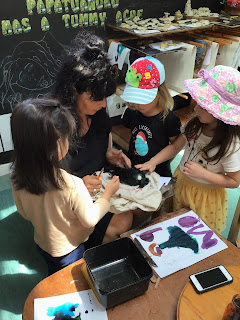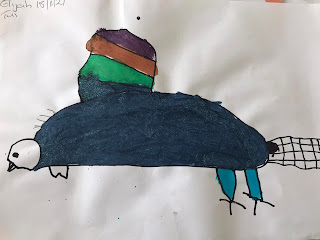A couple of weeks ago on a Monday, we received a call from Emma our administration superstar! To say that she had found a Tui, sadly this Tui had passed away. Initially I was hesitant to say bring it in, as the Tui I find are such majestic beautiful birds and I love watching them in my own back yard enjoying the kowhai flowers and on the Nature Programme flying, soaring and at this time of year very active and territorial.
Though after talking with the rest of the team, it was agreed that this would be a great learning opportunity for our tamariki and ourselves to be able to have a close up and real view of this beautiful bird.
"In Culture - Tui is a natural heritage animal - in Māori culture, the bird is associated with life fulfilment, confidence and spiritual harmony. They are said to be messengers of the Gods and Goddesses. They acted as a medium to communicate with the gods and goddesses in Māori beliefs"(https://www.nznature.net/)
For those of you who have never been to Mairtown Kindergarten, manu in particular the Tui is very special to us for many reasons. First it is on our Mairtown logo, it is displayed in many ways around our kindergarten, through art work that is hung on our walls, when a tamaiti leaves it is given in the form of a glazed tui as a gift, it is even on our kindergarten gates made out of wrought iron.
We also have a special 'Tui Award' for our tamariki - recognise tamariki who consistently demonstrate attributes of the kaupapa we are learning about and acknowledging at kindergarten. In early childhood there are many different ways to uphold the kaupapa of Tika; doing the right thing, Pono; being honest and truthful and Aroha; showing love and caring: all of which strengthen the leadership and learning potential of tamariki.
"Supporting children in their growing awareness and interest in animals can lead to deeper feelings of empathy in young children, more positive classroom relationships, and social-emotional development". (Selly, 2014)
Emma, brought the Tui into kindergarten and shared her story of how she found the Tui with the tamariki.
"Vygotsky’s theoretical perspective that an environmental playground provides a rich authentic context for children to learn from hands on active exploration of their environment. Combining children’s natural curiosity with animals provides a powerful pedagogical tool building children’s self-concepts, science skills, providing opportunities for children to develop sensory, physical, emotional, intellectual and social skills. Using animals as pedagogical tools within the early childhood context enables children access to unique opportunities to explore life processes and develop working theories that other pedagogical approaches simply do not offer." (Burr, 2016)
The Tui, was in perfect condition it just looked like it was sleeping. All the tamariki were fascinated, as were we, with seeing this beautiful manu so close. This started the conversation of "What do you think happened to the Tui"?
"I think his wings got wet and it made him not be able to fly and he fell down and got hit by a car" - Rada
"Tui hurt its neck, hurt arm and nose" - Kehlani
"Well I think someone accidently drived over it" - Riley
"Maybe a Myna bird was fighting the Tui and it killed it?" -Fisher
"Oh, no, it dead. It fall out of the tree. It fall off branch. It will get better, ohhh" - T
"He just got away from his friend because he got on the road and he dies. He's going to go back to his house. He just died and died and that's not good. He didn't want to die" - Indie
"I think he bumped into a tree because tree's make things die. If you bump into them" - Nikau
" I know, it flewed on the car through the window and bumped its head on the road" - Beauden.
"Maybe a car may have run it over" - Te Ariki
"Well I know that Tui died. He wanted to rest and he landed on the road instead of the tree and when he was resting on the road a car ran him over" - Hazel
"The bird donged it's head hard and that made it die. It was going to the muesli bar shop" - Maxwell
Feelings of empathy were also shared
"I just love him. Can we keep him? He has tickly white feathers. He banged his head. There is blood" - Lucas v.E
"Maz, do you love this bird? I love this bird, maybe we could have one of these birds, we don't have this bird" Te Ariki
"Studies show that around 2 years of age, children start to show genuine empathy, understanding how other people feel even when they don't feel the same way themselves. And not only do they feel another person's pain, but they actually try to soothe it." (Aberton, 2005)
Over the next few days, kaiako brought the tui out to show the tamariki that had developed an interest. It was interesting how the conversations changed and the tamariki were starting to observe small and different things about the tui.
"Look at it's tail. That is long tail so it can fly. He has white on him" - Leo.
"This is it's bell? This white thing, does it go biring a ding?" - Leina
"Do you know how they flap? They go up and down" - Leina
"It has a long beak, but don't touch the end, it's sharp" - Indi
"That's because he put's it in the flowers get the nectar" - Beauden
"I see the spiky stripy feathers around it's head" - Hazel
During this time tamariki also started to draw the tui, developing and supporting their further knowledge and understandings.
Elijah's observation's while drawing - "tuft - I didn't notice, I need to do that. He has a big head. He has a big body and a long tail at the back. His claws look like thorns. He has curly stripy white lines by his head and look he has these white feathers here".










































